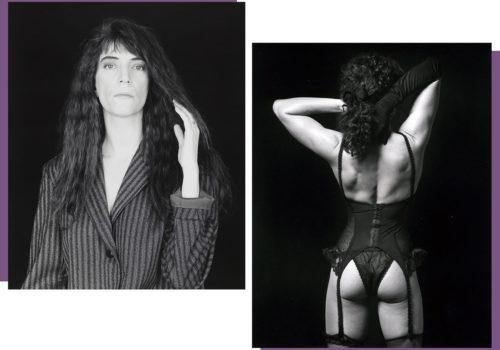This is the twenty-ninth dialogue from the Ettore Molinario Collection. A dialogue that pays homage to Lisa Lyon, a few weeks after the death of this extraordinary creature. And once more a dialogue between the women who accompanied Robert Mapplethorpe’s life and through whom the great photographer, and we with him, approached the mystery and power of different femininity.
Ettore Molinario
It happened a long time ago, and I purposely use this expression that belongs to myths and fairy tales because when the doors of Leo Castelli’s gallery in New York opened on March 5, 1983 and the public discovered the body of Lisa Lyon portrayed by Robert Mapplethorpe, it was like standing in front of a creature from another world. A creature who spoke the language of classical sculpture, who recalled Michelangelo’s paintings, his Sibyls, and who, wrapped in leather and silk, in a corset and whip, in guêpière and cheetah, redesigned the profile of the most fearsome dominatrix. I was in the audience and in front of that woman who had won the first women’s body building championship and who had held Arnold Schwarzenegger on her shoulders, a woman who was only one meter and sixty centimetres tall, something inside me too had begun to transform, to «build itself». Thinking about it clearly four decades later, I believe it was all about the pleasure of seeing the feminine and the masculine reunited in a single body, the codes and gestures that had defined both genders until then. Lisa, both woman and man. Lisa, spring spirit, born on May 13, 1953, who knew the primitive power of the earth and the delicacy of its buds.
Today I possess, and I insist on the physical meaning of possession, one of the images that I saw then. Those images, collected in the famous volume also published in 1983, have accompanied me in my history as a collector. I could say that I formed my eye for art around Lisa Lyon’s body. Mesmerised by her muscular transformism, I sought and found the same emotions in the metamorphoses of the Countess of Castiglione and the Marchesa Casati. Together with Lisa I entered the Berlin cabarets of the 1930s, I descended into the secret cellars of New York fetish and I traced back to its origins and its noble fathers, Charles Guyette, Irving Klaw, John Willie, all offsprings of my beloved Franz Rehfeld. And of course Lisa led me to Robert Mapplethorpe. Although years ago I was lucky enough to purchase one of his masterpieces, Man in Polyester Suit, I preferred to sell this image, the pinnacle of the Z Portfolio, and recompose the female pantheon of the great American photographer. And then Patti Smith appeared next to Lisa Lyon. Back and front of the same playing card.
We have all read and reread Just Kids, but of the union between Patti Smith and Robert Mapplethorpe I didn’t want the beginnings nor their youth – they were both born in 1946 – I wanted to relive the painful image of the farewell between two adults, who have loved each other and never really separated, not even when the paths of desire took two different directions. In 1986, at forty years old, Patti Smith poses in front of Robert. She is expecting a child, he is already seriously ill. The portrait is a tribute to the celebrity that both have so powerfully, muscularly sought and achieved, and is yet another form of body building. Patti Smith’s gaze is frontal, her face both severe and radiant with light, her body is tightened by the armour of a man’s jacket, which however leaves her neck shining up to the crease of her breasts. And then, what seduces me is that hand of the metropolitan Madonna, who blesses and greets. It’s no longer Michelangelo, but Giotto. At the end of his life, Mapplethorpe returned to the origins of Italian painting. And he remains loyal to Italian art even when he chooses a Gio Ponti desk for his studio, his last beautiful one on 23rd Street, a few steps from Chelsea. I didn’t know it yet, but now I realise that among the women who could inhabit Mapplethorpe’s powerful imaginative world there is also my wife Rossella Colombari, king and queen of historical Italian design.
Ettore Molinario
www.collezionemolinario.com
















